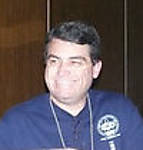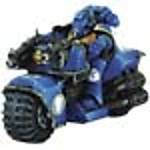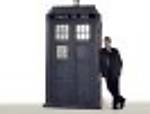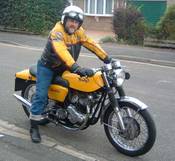United Kingdom
Joined: October 04, 2009
KitMaker: 1,209 posts
Armorama: 1,143 posts
Posted: Wednesday, March 24, 2010 - 09:43 AM UTC
Tom,
LOL
I hold you to that money back guarantee, mate!
I'm looking forward to meeting you all.
Talk soon.
Joe.

"Never get out of the boat. Absolutely goddamn right...unless you are going all the way".
On the bench:
Tamiya SAS Green Hornet Land Rover
Connecticut, United States
Joined: April 02, 2005
KitMaker: 3,608 posts
Armorama: 3,092 posts
Posted: Wednesday, March 24, 2010 - 10:40 AM UTC
Quoted Text
I have an Iwata HP CS and I use acrylic paints. Everytime I am done using it I run windshield washer fluid through it and just some water to clean out the cup. After reading this I will be using distilled water from now on.
I also do a complete breakdown of the air brush after every use. Once you get the hang of it, it is worth spending 5 minutes to clean it out.
Hi Miguel! Welcome to Armorama! Glad you're finding this forum useful.
Best,
Matt
SSG, INF, USA (Ret.)
"I am waiting for the tanks, and the Americans."
General Philippe Petain, September 1917
Connecticut, United States
Joined: April 02, 2005
KitMaker: 3,608 posts
Armorama: 3,092 posts
Posted: Wednesday, March 24, 2010 - 01:04 PM UTC
Quoted Text
Hi Matt,
Thanks for the tips. Looks like I'll be investing in more stuff then! Will I need more than 1 compressor?
Tell me a little bit more about pre-adjustment handles & micro control valves.
Anything to make life much easier I'm interested in.
If you like, you can PM me with the info & point me towards the right airbrushes & other airbrush tools I will need.
I look forward to hearing from you.
Joe.
Hi Joe,
No, you only need one compressor. If you go to the auto parts or hardware store, you can get 1/4" quick release fittings for your compressor and hoses. Then you can switch in a second. I have a hose for each brush and a male fitting for each hose. However, you can also buy the much smaller Iwata quick release fitting for the airbrush end of the hose, and put an Iwata male fitting on each airbrush. Then you only need one hose and you can change at the airbrush, not down at the compressor. Looking back, that's probably what I should have done.
Pre-set handle - all Iwatas except the Revolution and Eclipse lines come with pre-set handles standard. This is the handle of the airbrush with the little knob at the back. The knob limits needle travel, and thus allows you to pre-set the amount of paint that comes out when you pull back the trigger.
MAC valve - Tom took care of explaining this one. You can set your air pressure on the regulator at the compressor to like 20 lbs. and adjust it from 0 to 20 at the airbrush, much more precisely than at the regulator. And you can do it without taking your eyes off your model.
Best,
Matt
SSG, INF, USA (Ret.)
"I am waiting for the tanks, and the Americans."
General Philippe Petain, September 1917
United Kingdom
Joined: October 04, 2009
KitMaker: 1,209 posts
Armorama: 1,143 posts
Posted: Wednesday, March 24, 2010 - 06:33 PM UTC
Hi Matt,
Thanks for the info. I'm going to go out & invest in a couple more airbrushes & other bits & pieces that you've mentioned. I'll give you a shout when I've got them!
I'm going to get a hands-on display by Tom & the guys at his club. I think it's much better to actually have the airbrush in front of you so that an expert can explain exactly what he is talking about by pointing to the part in question so I know exactly what he is talking about.
I do really appreciate your help & look forward to asking your help in the future.
All the best to you, Matt.
Joe.


"Never get out of the boat. Absolutely goddamn right...unless you are going all the way".
On the bench:
Tamiya SAS Green Hornet Land Rover
Connecticut, United States
Joined: April 02, 2005
KitMaker: 3,608 posts
Armorama: 3,092 posts
Posted: Thursday, March 25, 2010 - 07:33 AM UTC
You're welcome Joe. I'm sure Tom and the club will get you up and running. Their collective knowledge is a priceless resource, make good use of it!
Best,
Matt
SSG, INF, USA (Ret.)
"I am waiting for the tanks, and the Americans."
General Philippe Petain, September 1917
United Kingdom
Joined: October 04, 2009
KitMaker: 1,209 posts
Armorama: 1,143 posts
Posted: Thursday, March 25, 2010 - 07:51 AM UTC
I sure will ,Matt.
I'll keep in touch as you are a font of knowledge about many things.
I've read a few of your threads & have been mightily impressed with your answers.
Talk soon.
Joe.
"Never get out of the boat. Absolutely goddamn right...unless you are going all the way".
On the bench:
Tamiya SAS Green Hornet Land Rover
Ohio, United States
Joined: May 28, 2005
KitMaker: 177 posts
Armorama: 108 posts
Posted: Monday, March 29, 2010 - 12:29 PM UTC
I'm a bit unruly in my airbrush cleaning and one night, not wanting to spend a whole lot of time on cleaning the week old enamel paints, I decided to brave it and used brake fluid to clean.
It did a remarkable job, faster and cleaner than other methods, but is it safe for the airbrush and o-rings? I...ahem...forgot about it one night and it ended up soaking for about 15 hours, but it came out fine. Just worried about the o-rings.
Connecticut, United States
Joined: April 02, 2005
KitMaker: 3,608 posts
Armorama: 3,092 posts
Posted: Monday, March 29, 2010 - 02:34 PM UTC
Eric,
I know that DOT 3 brake fluid strips models of enamel paint very well, but I've never heard of cleaning an airbrush in it. However, the seals and cups in brake systems are made out of rubber, so I don't know if it would eat the O rings or the packing. It sounds like it would be safe but only time will tell.
No matter what paint you use it's a really, really bad idea to let paint dry in your airbrush.
Best,
Matt
SSG, INF, USA (Ret.)
"I am waiting for the tanks, and the Americans."
General Philippe Petain, September 1917
England - East Anglia, United Kingdom
Joined: September 13, 2006
KitMaker: 257 posts
Armorama: 168 posts
Posted: Wednesday, May 26, 2010 - 10:06 AM UTC
04090
Hi Wain
I think you will get the distilled water at Asda and
what is wides in the states is windolien in the UK .
yours Cyril


Ontario, Canada
Joined: March 01, 2002
KitMaker: 1,607 posts
Armorama: 1,581 posts
Posted: Wednesday, May 26, 2010 - 10:31 AM UTC
I would take Matts advise.
I 've had my new airbrush for over 6 months and I always spray Windex through it and then some distilled water.
I only use acrylics with it and I haven't had any clogging yet.

British Columbia, Canada
Joined: May 05, 2009
KitMaker: 86 posts
Armorama: 83 posts
Posted: Thursday, June 10, 2010 - 01:58 PM UTC
um, I'd be careful with the brake fluid, as it might attack some 'chemically' different rubbers than what's in a brake system... and we really don't know what kind of rubber/s and plastic/s are in the airbrush, do we?
Writing Pennzoil...'excuse me, does your DOT 4 fluid attack the seals in my Iwata T1000?'.... they'd have no idea. !
Such a shame, as brake fluid is SUCH a nice stripper...
I don't buy models to stash them, I'd rather build 'em. So I don't have a huge stash. I don't count rivets, and I can appreciate the spirit of What-if-'46 campaigns. Mostly 1/35 ground militaria, my preferred topic. But I dabble. 1/48 B29 coming up s
Victoria, Australia
Joined: June 30, 2004
KitMaker: 65 posts
Armorama: 46 posts
Posted: Monday, June 14, 2010 - 07:01 PM UTC
I wrote up a visual guide for cleaning airbrushes for another forum - happy to repost it here if you like. Its only good for acrylic paint though.
I know its like giving a fuel-air explosive to a pyromaniac, but I really want to see the fuel-air explosive go off!
Zuid-Holland, Netherlands
Joined: May 07, 2009
KitMaker: 48 posts
Armorama: 40 posts
Posted: Monday, June 14, 2010 - 08:15 PM UTC
Hey Steve,
Yes please ... always handy!
gr.
(S)Martin
Victoria, Australia
Joined: June 30, 2004
KitMaker: 65 posts
Armorama: 46 posts
Posted: Tuesday, June 15, 2010 - 02:42 PM UTC
No problem, I'll throw it up now.
I know its like giving a fuel-air explosive to a pyromaniac, but I really want to see the fuel-air explosive go off!
Singapore / 新加坡
Joined: January 30, 2010
KitMaker: 45 posts
Armorama: 35 posts
Posted: Tuesday, June 29, 2010 - 02:32 PM UTC
Good thread here but I would like to ask something I'm not sure about.
I recently just bought an airbrush and the shop advised me after using, to clean the airbrush, I should just fill the cup with thinner from the DIY store and shoot till it runs clean. This is where I'm concerned about, I was told after shooting the thinner, I can just leave the brush alone. There's no need to clean it with water or anything after shooting the thinner to clean the paint out. At present, I'm using only Tamiya acrylic paints.
So would it be necessary to clean out the thinner?
Borsod-Abauj-Zemblen, Hungary
Joined: October 09, 2005
KitMaker: 626 posts
Armorama: 250 posts
Posted: Wednesday, June 30, 2010 - 03:54 AM UTC
Basically no, lacquer thinner is not supposed to leave any residue - let it dry and you can use it again. If you want to be sure, spray a few drops of acrylic thinner before you spray paint next time - my 2 cents.

Arkansas, United States
Joined: June 29, 2009
KitMaker: 11,610 posts
Armorama: 7,843 posts
Posted: Wednesday, June 30, 2010 - 01:07 PM UTC
I have a parts washer. Usually just wash with paint thinner or rubbing alcohol. After that, I run a bottle of water through the brush and use a needle reemer just in case. My Badger 150 works like the day I bought it.
Ideals are peaceful. History is violent.
New South Wales, Australia
Joined: November 10, 2005
KitMaker: 546 posts
Armorama: 442 posts
Posted: Wednesday, June 30, 2010 - 01:07 PM UTC
Quoted Text
Good thread here but I would like to ask something I'm not sure about.
I recently just bought an airbrush and the shop advised me after using, to clean the airbrush, I should just fill the cup with thinner from the DIY store and shoot till it runs clean. This is where I'm concerned about, I was told after shooting the thinner, I can just leave the brush alone. There's no need to clean it with water or anything after shooting the thinner to clean the paint out. At present, I'm using only Tamiya acrylic paints.
So would it be necessary to clean out the thinner?
What type of thinner are you using? If you are using Tamiya acrylics exclusively, then oil-based thinners such as mineral spirits or mineral turpentine are incompatible and won't touch Tamiya acrylics.
Lacquer thinner will rip it out pretty well, but you don't generally need to use anything that strong in normal use. I just use denatured alcohol (or Methylated Spirits) and it does the job quite well.
And again, no, you shouldn't need to clean the thinner out after cleaning, as it will simply evaporate. Actually if you flush your airbrush out with water, putting a little alcohol through it will help dry it out.
Singapore / 新加坡
Joined: January 30, 2010
KitMaker: 45 posts
Armorama: 35 posts
Posted: Wednesday, June 30, 2010 - 10:08 PM UTC
Thanks guys for the clarification. In that case guess I'll just leave the airbrush alone after cleaning it out with thinner. The thinner I am going to use should be a lacquer thinner as it cleans the tamiya acrylic paint off my paintbrushes very well.
Connecticut, United States
Joined: March 24, 2007
KitMaker: 317 posts
Armorama: 259 posts
Posted: Monday, September 13, 2010 - 03:29 PM UTC
ACLAD II Airbrush Cleaner will clean your airbrush completely...no doubts. This stuff is outstanding. Howeber, do not inhale it, or spill it on your skin while back flushing your brush. If you ahve any build up unside, disassemble the brush and soak for a few minutes in this product...no more problem.
Iain Hamilton
www.migjimenez.com
Connecticut, United States
Joined: March 24, 2007
KitMaker: 317 posts
Armorama: 259 posts
Posted: Thursday, September 16, 2010 - 01:40 AM UTC
Alclad II Lacquer air brush cleaner. This stuff will take the white off of rice but will not damage you airbrush. I will ocasionaly have issues with paint drying in the tip of my brush and this stuff will fix this real quick. Simply place a small amount into your paint cup and back flush your airbrush. If you still have an issue, I would suggest soaking the tip in a small amount of this thinner. DO NOT use this stuff to thin paint, DO NOT put it on your model unless you want to remove the paint, and do not breath it or spill it on your skin......or your wifes favorite shirt!
I do not know how some of the plastic parts in a TestersAztec brush would handle a thinner this "HOT" . Please, if anyone reading this has used this product to clean an Aztec, share the results with the group.
Iain Hamilton
www.migjimenez.com
England - South East, United Kingdom
Joined: December 13, 2004
KitMaker: 2,192 posts
Armorama: 1,615 posts
Posted: Thursday, September 16, 2010 - 09:09 AM UTC
I too have an old Badger 200 and I spray Humbrol through it, which is supposed to be really difficult. I've never plucked up the courage to try acrylics as I understand that they dry really quickly, and I've always been frightened of them clogging the brush - I suppose it's just what your used to. I don't clean when changing colour, just spray until the new colour comes through clean, but after every session I completely strip the brush and clean in White Spirit (much cheaper than special thinners and works just as well). This has worked for me for the last 30 years or more.
By the way if you want distilled water, just wait until your wife/mother defrosts the fridge. Collect it in a basin, let it melt and you have enough distilled water for months. Works fine in automotive batteries too and costs nothing.
"Lord Raglan wishes the cavalry to advance rapidly to the front, follow the enemy, and try to prevent the enemy carrying away the guns. Troops of Horse Artillery may accompany. French cavalry is on your left. Immediate. Airey."
California, United States
Joined: July 15, 2010
KitMaker: 297 posts
Armorama: 164 posts
Posted: Saturday, September 18, 2010 - 03:49 PM UTC
A cheap ultrasonic gizmo should work fine. Mine was $30 and works very well on anyting metal. I've never put my whole brush in - little worried about the rubber O-rings. Sure use it for needles and nozzle assemblies: it does work there.
As much as I dislike the stuff, I strongly believe that using lacquer thinner is terrific for blowing a brush clean. There are acrylics and acrylics. Some want water and nothing else. Gunze is only technically an acrylic and almost requires lacquer thinner for use. Tamiya acrylics sprays better in my humble with their lacquer than with their acrylic thinner (and it says so on their site if you look closely).
I've just bought some "green" lacquer thinner. Don't plan on using it for painting, but if it works well for cleaning, that would be sweet. It definitely does not have quite the punch smell-wise. Will report.
I don't dismantle the brush after each cleaning, but I do blow the tip out and swipe the needle after every color change and then give the thing a 45 psi full-bore blow out with about every solvent in the house at sessions end. (I think it important to get that first cleaning blast through ASAP - in just a few seconds - because some acrylics will clog up in the blink of an eye - so don't let them dry.) Then I check the brush before using next day with water: if it's not running smooth, you should see it right there.
Eric
Eric
A model boat is much cheaper than a real one and will not sink from under you.
Arkansas, United States
Joined: June 29, 2009
KitMaker: 11,610 posts
Armorama: 7,843 posts
Posted: Thursday, October 14, 2010 - 11:24 PM UTC
I wear a respirator(mask) and run MEK through my ab for about 15 seconds. This stuff is powerful and will disolve any foreign matter in your brush.
-Matt

Ideals are peaceful. History is violent.
Massachusetts, United States
Joined: September 20, 2010
KitMaker: 137 posts
Armorama: 100 posts
Posted: Saturday, October 16, 2010 - 02:53 PM UTC
Wondering if anyone uses ammonia (for acrylic) or white spirit (aka mineral spirit) for enamels?
Particularly interested in knowing if white spirit will damage various seals and o-rings.
My modelling time has been severely curtailed by a motorcycle accident. I'll do my best to complete the campaigns I have signed up for, but I think a few of them won't be done in time.







































































